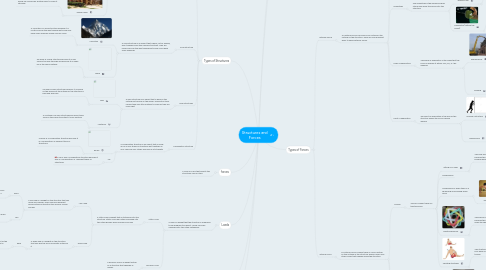
1. Structures
1.1. A structure is any object that has a working form and function. Structures could be classified farther into four gruops
2. Form and Function
2.1. Form is how the structure is shaped and function is what the structure is used for. But when building an object the designers must build it based on the function
3. Types of Structures
3.1. Frame structure
3.1.1. A frame structure is an object that is skeleton-like; because it is made up of different materials. These materials are called structural components. A frame structure could be just the frame itself or covered by another layer
3.1.1.1. spider web
3.1.1.1.1. A spider web is a frame structure because it is like a skeleton that is made up of different components.
3.1.1.2. house frame
3.1.1.2.1. A house frame is a frame structure because it would be covered by another layer to make it stronger.
3.2. Solid structure
3.2.1. A solid structure is an object that is hard, not as flexible, and it weighs more than hollow structures. They are usually solid all the way through but some could have small openings
3.2.1.1. a moutain
3.2.1.1.1. A mountain is a solid structure because it is mostly solid all the way through but some may have small openings inside such as caves.
3.2.1.2. apple
3.2.1.2.1. An apple is a solid structure because it is also solid all the way through and because it is made up of the same material.
3.3. Shell structures
3.3.1. A shell structure is an object that is hard on the outside but hollow on the inside. These structures usually take very little material to make so they are more light
3.3.1.1. egg
3.3.1.1.1. An egg is a shell structure because it is hollow on the inside but the outside of the structure is hard and shell-like.
3.3.1.2. container
3.3.1.2.1. A container is a shell structures because it hold food on the inside to protect it from bacteria.
3.4. Combination structure
3.4.1. A combination structure is an object that is made up of all four types of structures put together as one. They are very sturdy and have a lot strength
3.4.1.1. house
3.4.1.1.1. a house is a combination structure because it is a combination of different type of structures.
3.4.1.2. car
3.4.1.2.1. a car is also a combination structure because it also is a combination of different types of structures.
4. Types of Forces
4.1. External Force
4.1.1. An external force is a push or pull acting on the outside of the structure. There are four different ways to apply external forces
4.1.1.1. Direction
4.1.1.1.1. The direction you apply the force means if you push or pull the structure
4.1.1.2. Magnitude
4.1.1.2.1. The magnitude is the speed and how strong you apply the force onto the structure
4.1.1.3. Plane of application
4.1.1.3.1. The plane of application is the angle that the force is applied at. Either a 45, 90, or 180 degrees.
4.1.1.4. Point of application
4.1.1.4.1. The point of application is the area of the structure where the force is being applied
4.2. Internal Force
4.2.1. An internal force is when there is a force acting on the outside of the structure which causes four other forces that happen inside the structure
4.2.1.1. Torsion
4.2.1.1.1. Torsion is when there is a twisting force
4.2.1.2. Tension
4.2.1.2.1. Tension is when there is a stretching force the might lengthen the structure
4.2.1.3. Shear
4.2.1.3.1. Shear is when two forces are going in opposite directions
5. forces
5.1. A push or a pull that affects the structures load or itself
6. Loads
6.1. A load is a weight that the structure is supposed to be designed to support. Loads could be classified into two other categories.
6.1.1. Static Load
6.1.1.1. A static load is weight that is stationed onto the structure. Static could be further classified into two other groups; dead load and live load
6.1.1.1.1. Live Load
6.1.1.1.2. Dead Load
6.1.2. Dynamic Load
6.1.2.1. A dynamic load is a weight acting on a structure that changes or moves.
7. Center of Gravity
7.1. The center of gravity is the area on a structure that has the most mass/weight to make it stable. The area that the center of gravity is may change depending on the motion the structure is in.
8. Stabillity
8.1. Stability is how well the structure can balance itself and how strong it is. There can be ways to increase stability.
8.1.1. Wider base
8.1.1.1. If you lower the center of gravity on the structure then it would be more stable because there would be more support at the bottom
8.1.2. Symmetry
8.1.2.1. If the structure is symmetrical then it would be more stable because the weight would be more evenly distributed . Instead of one side being more heavy so it might tip over.

